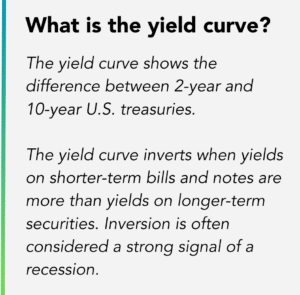No Headaches, Lower Costs
Markets In Focus: Further Uncertainty and Understanding the Economic Risks Ahead
Markets In Focus: Further Uncertainty and Understanding the Economic Risks Ahead
Key Points
- There’s little doubt that the U.S. economy will be in a fragile state in the coming months, as the yield curve remains inverted and the Fed seeks to return inflation to normal
- The U.S. economy is still growing, despite considerable uncertainty and indicators of a potential recession
- The Fed is likely to keep interest rates high for longer than initially anticipated, which could impact consumer spending, corporate debt, and more
Economically speaking, the theme of the third quarter revolved around a reversal of market sentiment.
Although we breathed a sigh of relief that the U.S. might not be in a recession, there’s also uncertainty about how stronger-than-expected economic growth and potentially stabilizing inflation might influence monetary policy decisions. Volatility and downside fears returned during the third quarter. Still, stocks remained resilient overall, and the U.S. economy continues to prove much stronger than most people expected.
There’s little doubt that the U.S. economy will be in a fragile state in the coming months and economic growth is likely to slow. The Fed continues to work towards returning inflation to more typical levels.
And it’s still unclear whether we’re in a recession or not—and it may not be known until many months after the fact. Many economists believe the economy could enter a mild recession later this year, and the indicators of recession may suggest a softer economic landscape than strong midyear growth data would suggest.
The yield curve inversion has long been seen as a predictor of recession.
For 15 months now, the yield curve has been inverted. However, the spike in bond yields over the last few weeks has been accompanied by a swift dis-inversion. And many argue that it’s not the inversion that spells trouble—it’s the subsequent re-steepening (the yield-curve dis-inversion).
While the inverted curve is an issue for financers, it hasn’t significantly affected everyday financial conditions for most people and companies. We will have to wait to see if the economy can escape without a recession, given the speed with which the curve has steepened.
Interest Rates
In September, Fed officials voted to keep interest rates steady while leaving the door open to another rate hike before the end of the year. The likelihood is growing that the Federal Reserve will keep interest rates high for a while. And that means the financial pressure on the most heavily indebted corporations is high.
- Refinancing corporate debt is becoming more difficult and debt bills are mounting.
- Bankruptcies among big companies are coming at the fastest pace since the pandemic, led by retailers and healthcare companies.
- Wall Street is bracing for more. The amount of debt trading at distressed levels indicates there is a rising risk of default, which has climbed more than 400% in the last two years.
Additionally, the markets also worry about interest rates remaining higher for longer. The Fed fears that lowering rates could throw gas on the economy and lead to continued high inflation. Even though inflation is beginning to return to normal levels, it’s still way too early to declare victory and the Fed will continue to be extra cautious.
If Interest Rates Stay High, How Will It Impact Different Parts Of The Economy?
While it’s good news that the U.S. economy is growing in spite of challenging conditions, the consequence is that prices continue to run hot, affecting consumers and their pocketbooks.
Spending vs. Saving
People are still spending at a high rate. However, it comes at a cost as consumers have been taking on more debt and saving less. For the first time ever, outstanding U.S. consumer loans exceeded $1 trillion in August. Meanwhile, the savings rate has been up and down. It currently sits at 3.9%, well below the 7% average savings rate of the past 25 years.
Student Loans
After a long break, Federal student loan repayments are set to resume in October. Most borrowers haven’t had to make payments since the start of the pandemic in 2020. This means approximately 43 million Americans will have monthly payments starting once again. Collectively, $1.6 trillion is owed in federal student loan debt.
- The Biden administration has unveiled SAVE, a new income-based repayment program with easier payment terms than previous plans.
- The administration also announced that borrowers who fail to pay won’t be referred to the credit bureaus for the next 12 months, so credit scores won’t be damaged. As a result, there will be less near-term incentive to comply.
- Also, high-income households owe a substantial amount of the debt and should be more able than lower-income households to maintain their spending despite the increase in debt payments.
Will student loan borrowers be able to keep up with the restarted payments? Probably so, although it’s also likely to cause spending in other areas to decline, which could weaken the overall U.S. consumer spending.
U.S. Government
National debt levels have risen sharply since the turn of the century, as deficit spending and massive fiscal stimulus packages followed the 2008 financial crisis and the 2020 COVID-19 economic crisis. The amount of publicly held debt as a percent of U.S. gross domestic product has reached its highest point since the end of World War II.
The concern around the rising levels of debt isn’t new. U.S. debt levels are often discussed each election cycle, but ultimately fade into the background. So why is it something that we should be mindful of today? As the level of debt has risen over the last two decades, the cost of servicing it has fallen because of low interest rates, which could now be changing.
An accommodative couple of decades from the Fed caused the debt cost to stay rather stable even though the amount of debt has risen. The average interest rate of outstanding U.S. debt hit an inflection point this past year, as the rapid hiking cycle has caused new issuance to be at much higher rates.
Looking forward
While the U.S. nonfarm payrolls print monthly employment report came in hot, the details are less favorable. The jobs report indicate that the Fed might have to hike rates even more, yet household employment is weak. Plus, soft wage increases and the flatness of hours worked suggest labor-market conditions are not quite so rosy.
If the Fed is looking farther ahead at the impacts its decisions will have, it is likely to stick to the view that the labor market is slipping. The risk of another rate hike this year has definitely increased, but there is also a reasonable probability for the Fed to simply hold rates steady for the rest of the year.
- The United Auto Workers strike could have a significant impact on the economy, even beyond the motor vehicle industry. A full strike could affect up to 760,000 jobs and reduce GDP growth. History suggests the effects begin spilling over into other industries after a month. If the strikes last the entire quarter, it could diminish long-term GDP growth.
- The tight labor market in the Midwest and South may be shifting. Many of those states stayed open during the pandemic and drew in people from coastal areas, which further heated up labor markets. Unfortunately, hiring in these areas is now showing signs of possible weakness ahead, as data suggests loosening from layoffs has increased in those regions.
Artificial Intelligence (AI) has garnered a lot of attention so far this year.
- The early beneficiaries have been semiconductor makers that generate revenue from the sale of chips to facilitate the ability to use AI. The focus of AI growth right now is the business-to-business market, where the efficient monetization of AI is the key.
- The generative AI tools like have captured public attention and also created significant advances for systematic investing. However, the implications are expected to be more evolutionary than revolutionary in nature.

Market in Review
Equity markets gave back some of the gains they saw over the year’s first half, with the Standard & Poor’s 500 index down 3.3% and the Russell 2000 down 5.1%. International markets also lost ground and were down slightly more than large-cap U.S. equities at negative 3.8%, while emerging markets equity declined 4.6%.
- The S&P 500 faced a second consecutive monthly decline in September, with 10 out of 11 sectors showing negative returns. The only exception was the Energy sector.
- Real Estate, Consumer Discretionary and Utilities sectors—which have inverse relationship to rising 10-year yields—experienced the most significant underperformance.
- Still, equity markets are having a great year. The S&P 500 is up 13.1% year-to-date, and the growth-focused Russell 1000 Growth index is up 24.98%.
- On the value side, however, the Russell 1000 Value is up only 1.79% year-to-date.
Fixed income markets have similarly had a challenging quarter as interest rates rose across the yield curve.
- The Bloomberg U.S. Aggregate Bond Index declined 3.23% over the last quarter, bringing its year-to-date return to negative 1.21%.
- And, even though the U.S. Treasury yield curve remains inverted, there was some normalization as rates further out on the curve increased more than those on the short end.
Corporate bond spreads were mixed during the quarter, with overall corporate option-adjusted spread decreasing slightly while high-yield corporate bond spreads widened by 0.08%.






